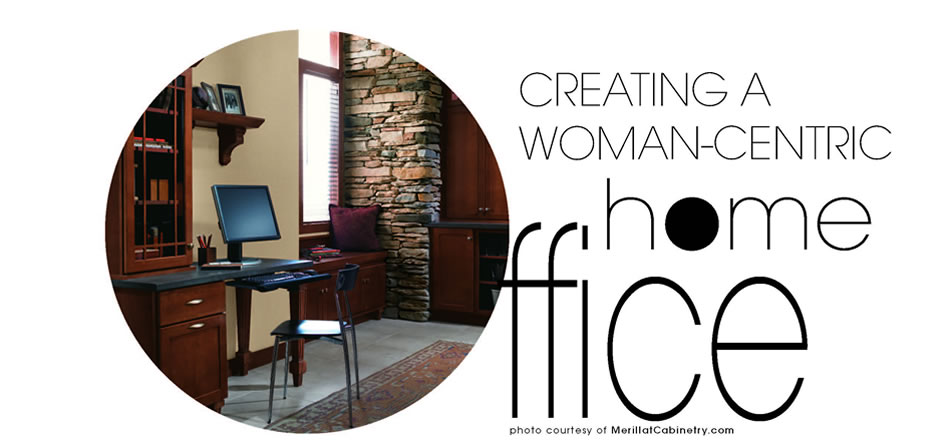Creating A Woman-Centric Home Office
According to WorkAtHomeInfo.org the are are 38 million home-based businesses in the United States today, depending on who’s doing the counting . Telework Research Center estimates another 20 to 30 million Americans currently work from home at least one day a week. Add to those statistics the millions of us who bring work home from the office to finish at night or on the weekends and it’s easy to understand the increasing interest in home offices.
We talked to a number of ladies who at least occasionally work from home and they shared wonderful insights and real world advice on creating an inspiring, productive home office.
TAILOR THE SPACE TO YOUR SITUATION AND NEEDS
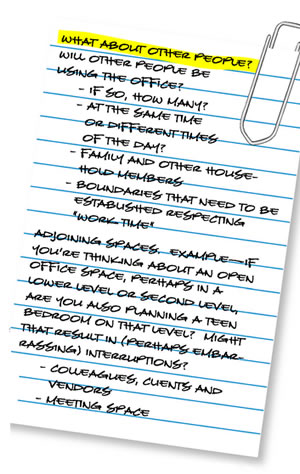 The type of work you will do from home is one of the first considerations. Ruth, a corporate recruiter, needs quiet privacy. Cindy, a seamstress whose specialty is repairing flags, needs a large open space for folding those 50-foot flags.
The type of work you will do from home is one of the first considerations. Ruth, a corporate recruiter, needs quiet privacy. Cindy, a seamstress whose specialty is repairing flags, needs a large open space for folding those 50-foot flags.
Take into consideration how often you will use this space (daily, twice a week, etc.) and whether it is your primary work space or simply supplements a traditional office elsewhere. Christy is an office manager who found a flex/computer room at home is fine for finishing accounting duties and other paperwork.
Also, how long at one time would you be using that space? The “occasionally bring a couple hours worth of work home from the office to finish it” need for office amenities is quite different from someone who will be using the home office for several hours at a stretch. Sheri, who was running a graphic arts business out of her basement lamented the lack of natural light. “It threw off my body’s bio-rhythms. Without windows I would totally lose track of time.”
LAYOUT
LOCATION As alluded to in the sidebar “What about other people?,” your privacy needs and whether or not you expect others in your home office help identify the best location for this space. When frequently meeting with colleagues and clients, a highly public location, such as a home office accessed from the entry foyer is often desirable. Conversely, many individuals who tend to work from home solo prefer a secluded location such as a rear corner in their home. Additionally, the question of a larger, open space vs. a more private space that can be closed off behind a door needs to be determined—often dictated by whether the office space will be kept clean and presentable all the time. If the flexibility of an open space is appealing, consider a divider such as bookcases or decorative panels to provide some privacy.
ACCESS
Location needs to be determined in tandem with access for your home office. A home office accessed from the entry is convenient and benefits from the design character of the entry foyer. Some home offices offer such public access as well as private access, such as from an adjoining master suite. Home work spaces accessed via a hallway can be made more special by careful selection of the door, perhaps a full-lite glass door. Do you have larger items going into this space? You’ll want to design with double
doors in mind. Is frequent shipping and receiving a part of your home business? Consider a secure shipping vestibule where delivery persons can drop off items rather than leaving them on your front porch. Or, at least locate your office within a few steps of where the shipments and deliveries take place. Finally, some people attempt to achieve more separation for their home office by having a separate exterior entrance into the home office for visitors. If this is your desire, consider the impact of that door’s location on the overall look of the front of your home as seen from the street.
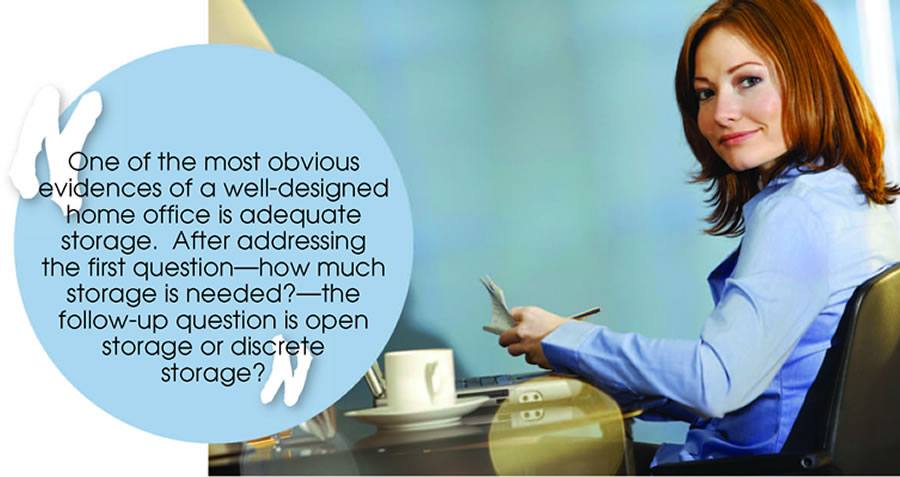
BATHROOM ACCOMMODATIONS
This might seem like a minor point, but is one that comes up in people’s regrets. Bev, who along with her husband runs a building company from their family home, didn’t plan for an extra bathroom to serve the home office. This resulted in construction personnel, clients and her kids all using the same bathroom. And what about you? If you’re going to build a 2-story home with your bedroom upstairs and a main floor home office, you’re probably not going to want to run upstairs every time you need to use the bathroom.
MAKING YOUR HOME OFFICE WORK
Having worked through the issues already discussed, it’s time to start designing your office space! Start with your actual work space. How much space do you need? Is the type of work pretty consistent or should this space be fairly flexible for easy re-configuration as needs arise? And what type of furniture do you want? While some women we spoke with described a traditional desk setup, more often we heard requests for work surfaces that were counters or tables, not desks. The seating you will primarily use is one of the most important considerations. If you will typically be seated in front of a computer or at a desk/workstation, posture and ergonomics are critical to reduce fatigue, increase comfort and productivity. Be sure to look for chairs that tilt, swivel and move easily on the flooring. Additionally, many people working from home are looking for another, more comfortable chair in their home office. Two such seating options address task-oriented work as well as fostering out-of-the-box creativity.
Often an afterthought, consider the seating position and whether you would be facing others as they walk by or enter this space, or whether your back would be turned to them. Most of us feel uncomfortable when others see us but we’re not aware of them. If the only option for a functional workspace requires having your back exposed, think about placing a mirror directly in front of your workspace to observe what’s going on behind you.
LIGHTING
A nearly universal desire with regard to home offices is lots of natural light. Exposure to natural light has numerous health benefits, both physical and mental. Importantly, natural light has been shown to improve concentration, reduce eyestrain and fatigue, and generally improve mood. For some who work from home, natural light must be accompanied by operable windows for fresh air and calming breezes and nature sounds. Another camp requests multiple high transom windows only, providing the desired sunlight but avoiding the distraction of movement outside. When increasing windows simply is not an option, consider adding skylights to the home office space. Control over lighting makes a big difference.
For natural light, that usually means easy-operating window shades or blinds. For added lighting, dimmers and individual on/off controls for the various lighting fixtures is welcome. Try to avoid lighting directly overhead computer screens as that can cause glare problems. Similarly, bright sunlight can wash out computer screens, another factor in deciding the best workspace design.
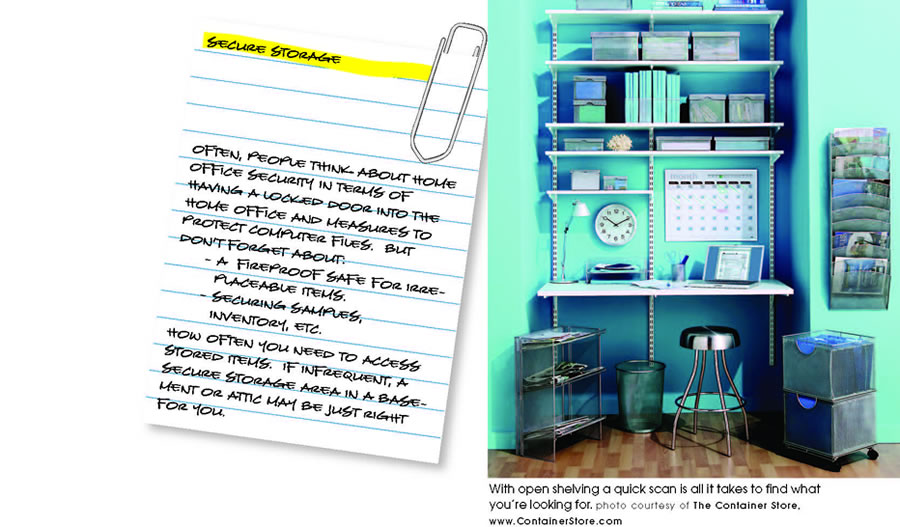
Generally, people prefer lighting fixtures other than fluorescent tubes. When planning for lighting, combine general illumination (i.e., ceiling fixtures) with direct task lighting and indirect/accent lighting such as recessed lights and wall sconces. Care should be taken in choosing light bulbs and their “color temperature.” Incandescent, compact fluorescent, halogen and LED lights vary in color temperature, ranging from blue and green hues to more reddish and yellow shades. Many of today’s light bulb manufacturers offer color temperature choices across the different types of bulbs which you can try to match.
STORAGE
One of the most obvious evidences of a well-designed home office is adequate storage. After addressing the first question—how much storage is needed?—the follow-up question is open storage or discrete storage? Open storage, such as cubbies and shelving units, provides for quick scanning to locate what you’re looking for. Based on what you choose to have on display, it can also speak volumes about you to others who come to visit you. If wall shelving is your preference, be sure to note the weight which the shelves are designed to hold. A dramatic alternative to traditional wall shelves are glass shelving products that appear to “float” without visible brackets and hardware. Discrete storage includes all types of closets, cabinets, files, etc.. Perhaps the most obvious benefit is visual—the reduction of clutter and a streamlined, organized appearance of the home office. Flexibility comes into play with storage, as several ladies identified a desire for easily reconfigurable storage systems such as stacking units and storage cabinets on casters. If storage is to be permanent, such as cabinetry or furniture, pre-plan amenities such as pull-out drawers and other built-ins.
The opportunity of a storage area closed off by a door, curtains or even sliding walls from the rest of your home office allows you to keep everything from client files to paper clips to your fax machine out of public view. As well, such discrete storage areas do not necessarily have to be kept as tidy as the more public areas of your home office. Planning for waste is essential and practical. Avoid future regrets by deciding now the wastebasket size and placement (a pull out wastebasket drawer is wonderful!), and how to incorporate a recycling center.
ORGANIZATION
A close cousin to storage is organization. Visual scheduling and organization of concurrent projects came up often in our discussions, with typical solutions identified as large, write-on wall calendars and large “idea walls” which were usually envisioned as long bulletin boards or magnetic boards for temporarily adhering items to the wall (does your home office offer such wall space?) Write-on white boards were also frequently mentioned.
Large work surfaces were similarly important for organizing multiple projects in progress. Not having to stash everything else away when a conflicting deadline demands immediate attention is golden. Finally, determine where the items you need most frequently will be kept. Organizer accessories for everything from staplers and paper clips to pens and Post-It notes are one way to keep things organized. The bottom line—clutter sucks energy out of you. You won’t be happy (or productive) in a cluttered home office!
COMMUNICATION NEEDS
While the proliferation of cell phones makes having a separate land line for your home business optional, it’s probably wise to at least drop a phone jack into the future home office space. And if you have a separate fax machine from your office phone, might as well make that 2 phone jacks being installed. Importantly, the location of those jacks can in large part minimize visible phone wires, so care should be exercised in having those jacks placed exactly where you want them.
Computers have become an indispensable communication tool, and though many people are enjoying wireless connectivity between computers, to the internet and to the printer/ scanner, currently the speed and reliability of wireless networks does not yet rival the traditional “hardwired” approach. At the time a home is being built, pulling data cabling into your future home office area represents a very minor expense which makes it a good investment.
Also, folks working from home often talk about the need for a TV/DVD player in the home office. From watching training videos to monitoring news headlines and the weather, plan for where a TV would work well. If others may be joining you in your home office gathered around that TV, its location becomes even more critical. Electrical outlets and cable TV jacks properly located will again minimize visible wiring.
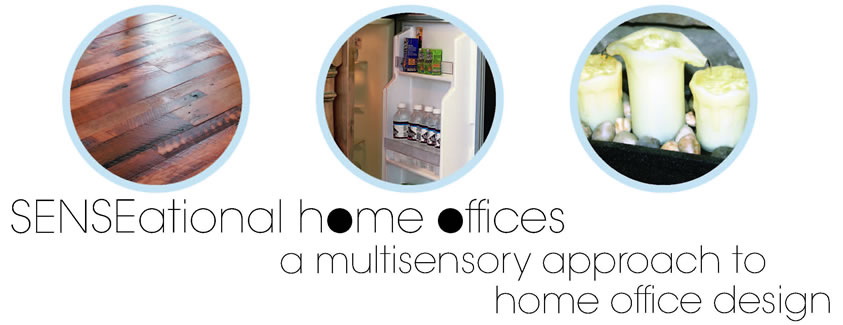
Taking a woman-centric approach to home office design means designing the environment for all of our senses. Compared with men, women’s senses are generally more acute than men’s, with women taking in much more than the guys via sensory appeals.
The materials you select, such as flooring, wall textures and furnishings all contribute to the overall look you achieve.
TOUCH AND FEEL
Certain products practically beg to be touched. Natural stone counters or work surfaces…interesting hardware…soft-closing doors…all are enhanced via their feel. Heavy, solid doors have a sense of heft that translates into security, permanence and success. Quality carpeting with a thick pad exudes a sense of luxury and comfort, while tile or wood flooring suggest traditional sophistication. Almost too obvious, the heating and cooling of your home office space is an issue of touch as well. If there are multiple electronic gadgets running, you may well produce excess heat which could make your office uncomfortably warm in the summer, though the rest of the home is cool. Be sure to discuss this aspect with your builder and heating/air conditioning contractor.
TASTE
Though perhaps the least important when it comes to designing your home office, many telecommuters wish for a mini fridge and/or bottled water dispenser in their home office for themselves and their guests. Individuals who prefer their caffeine hot desire a coffee station or at least hot water for tea. Yes, the kitchen may only be steps away, but that trek to the kitchen may interrupt a critical line of thought you are working with. So, reflect on your beverage preferences, factor in refreshments for visitors and talk about this issue with your builder (and possibly the plumber!)
SOUNDS
This is an interesting paradox—people are either striving to achieve serenity by minimizing noises that may be audible in the home office, or, people seek to add sounds to their home office to actually aid concentration or create a more calming or invigorating work area.
Many things can be done to help soundproof a home office space. A major aspect is the flooring choice. Carpet and pad absorbs a lot of sound, but noises typically bounce off of hard flooring such as ceramic, woods, laminates and concrete. If you opt for hard surface floors, think about large area rugs to help control sound levels. Solid core doors, as opposed to less expensive hollow core doors, help keep other household noises out. Locating the home office away from frequently used areas of the home or loud areas such as a media room is important. And if peace and quiet is at the top of your list, talk to your builder about different soundproofing measures from insulating the walls to using quieter drywall products.
On the other hand, adding background music can have a similar effect, in that you’re not as likely to hear other extraneous noises. We also heard several requests for natural sounds, whether that be operable windows opened for Mother Nature’s serenade or wind chimes.

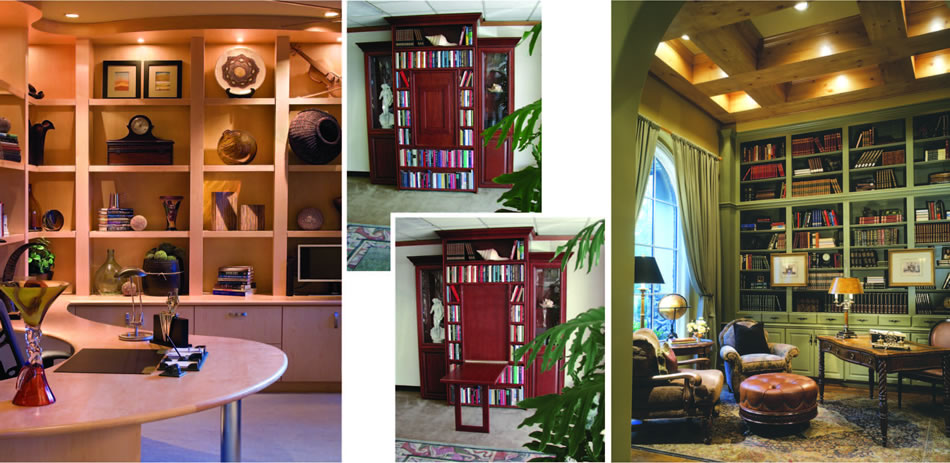
SCENTS
This one is pretty straightforward. Fresh air and proper circulation help eliminate odors. An air cleaner makes a big difference for smoking environments or if your particular business deals with a product that has its own distinct smell. In addition, lots of women add fragrance to the home office environment. Essential oils, fragrant candles and potpourri can help create a pleasing aroma. A word of caution—as you become used to your home office setting, you may be tempted to add higher levels of fragrance. Don’t, as it will overpower visitors!
VISUAL
This is limited only by your imagination. The materials you select, such as flooring, wall textures and furnishings all contribute to the overall look you achieve. Because they serve as the backdrop to most everything else, your walls (and ceiling—the “5th wall”) and the paint or wall paper chosen have a major impact on the visual story told by your home office.
First impressions are strategically important if you will have clients and co-workers in your home office. As you approach the office area, what do you see? (Note, studies show women have greater peripheral vision than men!) Upon entering your home office, what is the main focal point? The decorations, the furnishings, the materials and surfaces and colors, unique pieces—what do you want them to say about you? Finally, what about you? What in your home office space would inspire you? Is it family photos or memorabilia? A waterfall? Artwork? These are “must-haves” in your new home office!
